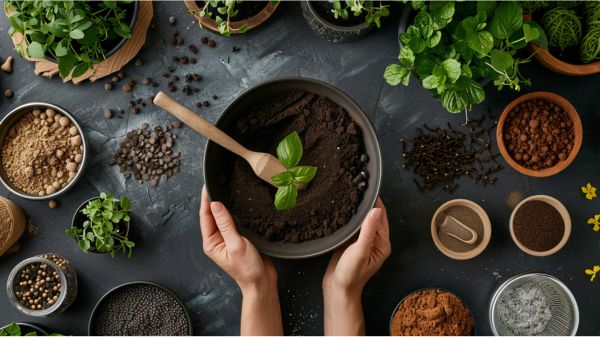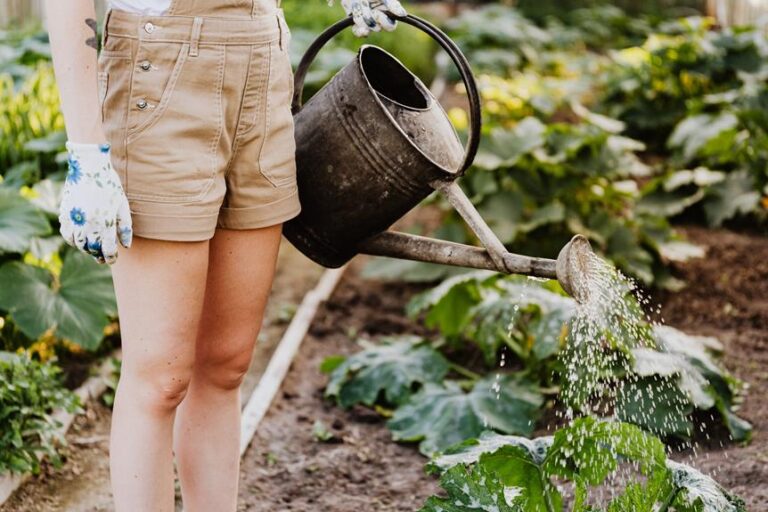10 Best DIY Soil Mix Recipes for Houseplants
When it comes to nurturing your houseplants, remember that ‘the proof of the pudding is in the eating.’ As you navigate the world of DIY soil mix recipes, each blend holds the potential to unlock the secret to healthy, thriving plants within your home.
From specialized concoctions for cacti to moisture-loving ferns, the possibilities are endless.
Explore the nuances of soil composition and plant care through these curated recipes, and discover how a tailored mix could be just the missing ingredient your indoor garden needs.
Key Takeaways
- Perlite enhances aeration and drainage in soil mixes for healthier roots.
- Organic compost enriches soil with essential nutrients, promoting plant growth.
- Tailored soil blends cater to specific plant needs for optimal health.
- Using specialized mixes like cactus soil enhances plant growth in suitable conditions.
Basic Ingredients for DIY Soil Mix
When crafting your DIY soil mix for houseplants, the basic ingredients are essential to ensure optimal aeration, drainage, and nutrient balance. Start with potting soil as the base, providing a solid foundation for your plants.
Incorporate perlite into the mix to improve drainage and aeration, crucial for preventing root rot. Organic matter, such as compost or worm castings, adds valuable nutrients to support plant growth.
Balancing these components is key; too much perlite may cause the soil to dry out quickly, while an excess of organic matter can lead to water retention issues. Understanding how each ingredient contributes to the overall mix will help you tailor it to the specific needs of your houseplants, promoting their health and vitality.
Related Post: Top Practices for Indoor Gardening Pest Control.
Coco Coir Soil Mix Recipe
You may benefit from using a coco coir soil mix due to its sustainable nature and excellent water retention properties. This alternative to peat moss offers a pH-neutral environment that aids in root stability and growth.
Mixing coco coir with perlite and vermiculite can create a well-balanced soil blend that promotes both drainage and moisture retention for your houseplants.
Benefits of Coco Coir
Derived from coconut husks, coco coir offers houseplants a sustainable alternative to peat moss with its excellent water retention and pH neutral properties.
When using coco coir in your soil mix, you can benefit from:
- Reduced watering frequency due to its exceptional water retention capabilities.
- Providing a stable growing environment for plant roots with its pH neutral nature.
- Promoting aeration and preventing soil compaction, aiding in drainage and supporting healthy root development for your houseplants.
How to Use
To incorporate coco coir effectively into your houseplant soil mix, consider blending it with perlite and vermiculite for a well-balanced and nourishing growing medium. This combination provides excellent moisture retention, aeration, and nutrient availability for your indoor plants.
Below is a simple table to guide you in creating the perfect coco coir soil mix recipe:
| Component | Purpose | Amount |
|---|---|---|
| Coco Coir | Sustainable alternative to peat moss | 50% |
| Perlite | Improves drainage and aeration | 30% |
| Vermiculite | Retains moisture and nutrients | 20% |
Peat Moss-Based Mix for Houseplants
Peat moss serves as a crucial component in houseplant soil mixes, playing a vital role in maintaining optimal moisture levels essential for plant growth and root development.
When creating a peat moss-based mix for your houseplants, consider the following:
- Moisture Retention: Peat moss excels in retaining moisture, ensuring your plants have a steady water supply.
- Root Development: It provides a stable environment for roots to grow and helps in nutrient absorption.
- Balanced Mix: Combining peat moss with perlite and vermiculite creates a well-draining yet moisture-retentive soil blend ideal for the thriving growth of your houseplants.
Biochar Enriched Soil Blend
When considering a biochar enriched soil blend for your houseplants, you’re exploring a method to enhance soil fertility through beneficial microbial activity. This soil amendment aids in nutrient retention and limits leaching, ultimately improving your plants’ access to essential nutrients.
Benefits of Biochar
Harness the power of biochar-enriched soil blends to optimize the growth and health of your houseplants. Biochar, a product of pyrolysis, offers numerous benefits for your plants and the environment:
- Enhanced Soil Health: Biochar improves soil structure, fosters beneficial microorganisms, and promotes a healthy soil ecosystem.
- Improved Water Retention: The addition of biochar helps soils retain moisture, reducing the frequency of watering and promoting drought resistance.
- Increased Nutrient Availability: Biochar enhances the availability of essential nutrients to plants, supporting their growth and overall health.
Incorporating biochar into your soil mix can lead to lusher, healthier plants while reducing the environmental impact of your gardening practices.
How to Make
To create a biochar-enriched soil blend for your houseplants, begin by gathering the necessary ingredients and tools. Biochar is essential for enhancing soil fertility and promoting plant growth. Follow this simple recipe to make your own biochar-enriched soil mix:
| Ingredients | Amount | Purpose |
|---|---|---|
| Peat | 2 parts | Improves water retention and aeration |
| Sphagnum Moss | 1 part | Enhances moisture retention and promotes root growth |
| Biochar | 1 part | Increases nutrient retention and supports microbial activity |
| Garden Soil | 1 part | Provides essential nutrients for plant health |
| Perlite | 1/2 part | Aids in drainage and prevents compaction |
Mix these ingredients thoroughly to create a well-balanced biochar-enriched soil blend for your houseplants.
Best Plant Applications
For optimal plant growth and health, consider using the biochar-enriched soil blend in plants that thrive in well-draining conditions.
Biochar-enriched soil blends offer a range of benefits for your houseplants, including improved soil structure, enhanced fertility, and better moisture retention. The addition of biochar creates a favorable environment for beneficial microorganisms, supporting the overall health of your plants.
Furthermore, the porous nature of biochar aids in nutrient absorption, ensuring that your plants receive essential nutrients for their growth. This enhanced soil blend also promotes healthy root growth, allowing your plants to establish strong and robust root systems.
Incorporating biochar-enriched soil blends contributes to long-term soil health and sustainability in your plant cultivation practices.
Vermiculite-Infused Potting Mix
Enhance your houseplant’s growth and health by incorporating vermiculite into your potting mix for optimal root development and soil aeration.
Vermiculite, a lightweight mineral, improves soil aeration, moisture retention, and nutrient availability, creating an ideal environment for your plants. By adding vermiculite to your potting mix, you ensure proper drainage, preventing soil compaction and promoting healthy root growth.
The porous nature of vermiculite allows for efficient water absorption and release in the soil mixture, maintaining the right balance for your houseplants. Its benefits make it a popular choice for tropical plants and seed starting mixes. Give your plants the best chance to thrive by including vermiculite in your DIY soil mix recipes.
Perlite Soil Mix for Indoor Plants
Perlite is a valuable addition to indoor plant soil mixes as it aids in soil aeration and drainage, preventing compaction and promoting healthy root development.
Mixing perlite into your potting mixes can help retain moisture while creating a well-draining environment for your plants. Consider using perlite for succulents, cacti, and other houseplants that thrive in well-draining soils.
Benefits of Perlite
With its lightweight and porous nature, Perlite significantly benefits indoor plants’ growth by enhancing soil aeration and drainage. Adding Perlite to your soil mix can lead to healthier root growth and prevent issues like waterlogging and root rot.
This volcanic mineral aids in creating a well-structured potting mix that allows for optimal oxygen penetration to the roots of your houseplants. Here are three key benefits of using Perlite in your indoor plant soil mix:
- Enhances soil aeration, promoting robust root development.
- Improves drainage, preventing waterlogged conditions and root rot.
- Helps prevent soil compaction, ensuring better oxygen flow to plant roots.
How to Mix Perlite
Mixing perlite into your indoor plant soil blend ensures optimal aeration and drainage for healthy root development. Perlite, a lightweight volcanic mineral, is key in enhancing soil mixes for indoor plants.
To create a well-draining environment, combine perlite with potting soil at a 1:1 ratio. This blend helps prevent soil compaction, promotes root health, and improves moisture retention without causing waterlogged conditions.
When preparing your potting mix, simply measure out equal parts of perlite and potting soil, then thoroughly mix them together. The perlite’s porous nature allows for increased airflow through the soil, facilitating better oxygen circulation around the roots.
Best Plants for Perlite
To ensure your indoor plants thrive with optimal aeration and drainage, it’s essential to select the right plants that complement the benefits of perlite in your soil mix. When choosing plants for perlite soil mixes, consider the following:
- Succulents: Succulents, such as Aloe Vera and Echeveria, thrive in well-draining soil, making them perfect companions for perlite-enhanced mixes.
- Cacti: Cacti, like the popular Prickly Pear or Barrel Cactus, also benefit from perlite’s ability to improve soil drainage, preventing water stagnation.
- Drought-Tolerant Species: Plants that prefer sandy or rocky soils, such as Snake Plants or Zebra Haworthia, flourish in perlite mixes due to enhanced root development and aeration.
Choose these plants to create an ideal environment for your indoor garden with perlite-infused soil blends.
Nutrient-Rich Compost Blend
Enhance the fertility of your houseplant soil and foster robust plant growth with a nutrient-rich compost blend. Compost, rich in organic matter and beneficial microorganisms, is a cornerstone of sustainable gardening.
When mixed with potting soil, compost enriches the soil with essential nutrients, improving its structure, moisture retention, and aeration. Homemade compost blends not only reduce the reliance on synthetic fertilizers but also support the overall health of your plants.
Organic Fertilizer Soil Recipe
Transitioning from the nutrient-rich compost blend, now let’s explore an organic fertilizer soil recipe to further nourish your houseplants naturally.
When creating your organic fertilizer mix, consider the following ingredients:
- Compost: Rich in organic matter and beneficial microbes, compost provides essential nutrients for plant growth.
- Worm Castings: Enhancing soil fertility and structure, worm castings are a valuable addition to your mix.
- Manure: With nutrients like nitrogen, phosphorus, and potassium, manure promotes healthy plant development.
Drainage-Enhanced Potting Mix
Consider incorporating perlite into your DIY soil mix recipe to enhance drainage and promote optimal plant health. Perlite, a lightweight volcanic glass, increases aeration by creating air pockets in the soil, preventing waterlogging.
This drainage-enhanced potting mix is perfect for plants that thrive in well-draining soil. By adding perlite, you help prevent root rot by ensuring excess water drains away from the roots, promoting healthy root development and overall plant growth.
The improved drainage provided by perlite allows oxygen to reach the roots more efficiently, supporting plant respiration and nutrient uptake. Including perlite in your DIY potting mix recipe is a simple yet effective way to create a conducive environment for your plants to flourish.
DIY Cactus and Succulent Soil Blend
To create a suitable soil blend for your cactus and succulent plants, ensure you include potting soil, coarse landscape sand, and perlite in the right proportions to maintain proper aeration and moisture levels.
When mixing your DIY cactus and succulent soil blend, follow the recommended ratio of 3 parts potting soil, 2 parts sand, and 1 part perlite. This combination aids in providing the necessary drainage and aeration these plants require for optimal growth.
Consistent measurements of these components help in achieving a balanced and effective soil mix for your cacti and succulents. By customizing your own soil mix, you can cater to the specific needs of your plants, steer clear of harmful chemicals, foster healthy growth, and cut down on expenses.
Frequently Asked Questions
What Is the Best Recipe for Indoor Potting Soil?
For your indoor potting soil, blend 50% Premium Potting Mix with 50% Perlite. This mix aids in moisture retention, drainage improvement, and aeration benefits, ensuring nutrient balance for your plants. Consider adding horticultural charcoal for pH control and fertilizer incorporation.
What Do You Mix Soil for Indoor Plants?
When mixing soil for indoor plants, ensure your blend strikes the perfect balance. Incorporate ingredients like potting soil, sand, perlite, and horticultural charcoal. This concoction will provide the ideal environment for your plants to thrive.
What Is the Best Soil Mixture for Potted Plants?
For potted plants, you need a mix that balances water retention, nutrient supply, and good drainage. Avoid garden soil, opt for a blend with organic materials like compost. It aids aeration, supports root health, and ensures proper pH levels.
What Is the Best Indoor Soil Mix?
For the best indoor soil mix, combine premium potting mix with perlite for aeration. Add horticultural charcoal for filtration and root health. Ensure good drainage to prevent overwatering. Maintain moisture balance for healthy plants.
Conclusion
Now that you’ve got your hands dirty mixing up these soil recipes, your plants are sure to thrive and grow with vigor. So go ahead, get your hands in the soil, nurture those roots, and watch your houseplants flourish in their custom blends.
Remember, a happy plant starts with healthy soil – so keep experimenting, keep learning, and keep your plant community thriving.
Happy planting!






